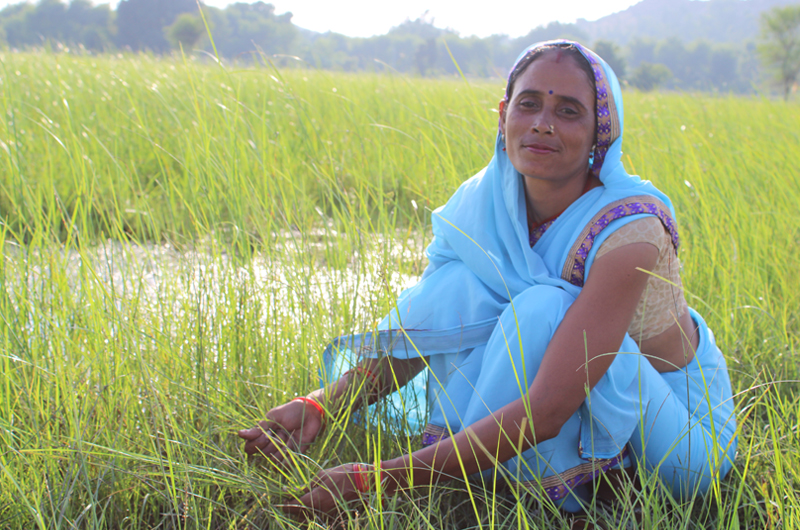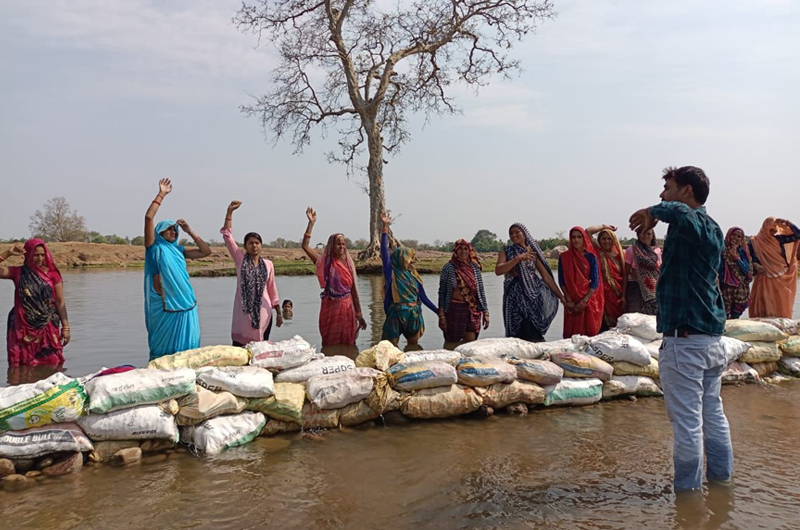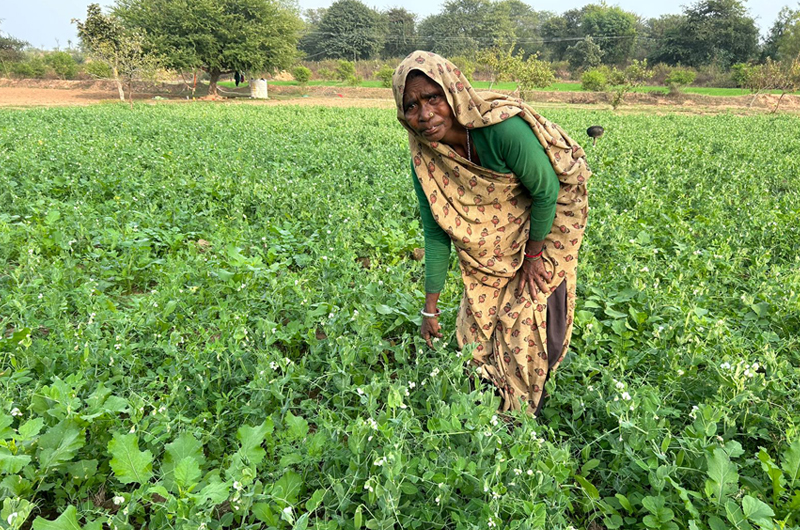Bharat Dogra profiles brave women from underprivileged or less privileged backgrounds, who, despite the lack of monetary returns, undertake back-breaking work to ensure that their villages have enough water for their needs. These case studies illustrate that voluntary organisations can play an important supportive role in implementing small-scale water conservation taken up under various government schemes for the benefit of farmers in water-scarce areas
Sharda Vanshkaar, who hails from a remote village in Bundelkhand, may appear simple and gentle, but she recently received the prestigious Catch the Rain Award from President of India Draupadi Murmu, for her extraordinary achievements. When I met her in her village in early December, she asserted that she would continue to work with commitment and dedication, as there is so much more to be done.

Sharda, who belongs to a small farmer family, had been noticing that due to water scarcity, many farmers in her village were not able to cultivate their fields and were forced to work in exploitative conditions as migrant labour far away from home. Ironically, the Barua River flows nearby, but an old check dam on the river had fallen into disrepair. Ruthless sand mining hampered the water flow too, so that the thirsty fields got no relief. So, when activists from a voluntary organisation, Parmarth, came to her village to organise meetings on water conservation, Sharda mobilised about 30 other women to work with Parmarth.

Undeterred by the lack of funds, Sharda and her friends decided to make a temporary bund of sandbags so that farmers would be able to irrigate at least their standing crops. Parmarth provided about 5,000 sacks which were filled with sand and strategically placed with the help of the men folk. A significant number of farmers benefitted. However, illegal sand mining continued to be a problem. The women got together to complain to the administration regarding this, and action was taken after an inquiry. These are only stop-gap solutions though. Constant vigilance is needed to check sand mining, and to see that the sandbags remain in place. Sharda says she and her friends will continue to work for this.
Sharda has also been associated with activities such as checking open defecation and promoting kitchen gardens. During COVID, when villagers badly needed livelihood support, she helped Parmarth take up tank improvement work to improve water retention. While Sharda has helped install new hand pumps, she regrets that though water pipelines and taps have been provided, and a water tank built, water supply to the village was only given on a trial basis. She is determined to see that water reaches all taps in her village, as promised by the government. By combining caution with courage, Sharda and her friends have achieved big things in a short time, with promises of more to come. Recognising her efforts, Sharda has been named a jal saheli (water friend) by Parmarth, as part of a programme to train rural women volunteers on water conservation, public hygiene and related issues.
As ground water is tapped more and more to meet the requirements of rural homes, the need for water conservation is proportionately increasing, and community mobilisation to check this and other trends has become imperative. It is in this context that the cadre of rural women volunteers devoted to water and sanitation needs of villages, with special emphasis on water conservation, started by Parmarth in the Bundelkhand Region, covering parts of Uttar Pradesh and Madhya Pradesh, has gained significance. Starting with a jal saheli named Sirkunwar about a decade ago, the initiative already has about 1600 volunteers and there are plans to increase their number and extending the effort to states like Rajasthan and Haryana. The jal sahelis are identifiable by the sky-blue saris they wear. Several of them, apart from Sharda, have won government awards like Catch the Rain, Water Warrior and Jal Prahri.
Imarti is one of the awardees. She, along with two friends, worked hard to dig a well in very difficult rocky conditions, winning the respect of the entire community and prompting more people to pitch in and complete the task. Meera has been very active in the ODF campaign in her village in Jhansi District. In Hamirpur District, Kunti led women in a project to clean a degraded water tank, succeeding where a contractor and his workers had failed earlier. Deepa made such an impact by her campaign and voluntary work that she was elected as the village sarpanch (head), enabling her to contribute even more. Sona has helped in the successful implementation of not just water conservation work but also in promoting natural farming and millet cultivation, exemplifying the many-sided contributions of jal sahelis.
However, the core area of jal sahelis remains water conservation, meeting water needs and improving sanitation. Under the Jal Jeevan Mission, the jal sahelis help sort out initial problems such as households not being covered by the pipeline link. Under Parmarth’s water and sanitation projects, jal sahelis have been active members of a wider community organisation on water-related issues, called Pani Panchyat. Select sahelis are given capacity building training and exposure to successful projects and fellow Sahelis from other places. These women, generally from families of modest means or even poor households, work without salary or honorarium, and their efforts deserve high appreciation. Sanjay Singh, secretary of Parmarth, is determined to spread the concept of jal sahelis to more villages.
Geeta, one of the jal sahelis, has won not only the government’s Water Warrior Award, but also a UNDP recognition for the important role she played in mobilising the community for the cleaning and repair of Maanpur Tank in Jhansi District, constructed during the times of the Chandel kings several hundred years ago, and once a source of great pride for the villagers. A canal fed by the tank was an important source of irrigation. However, the canal was badly damaged, considerably reducing the tank’s irrigation potential, forcing village women to risk their lives and limbs, crossing major roads to fetch water.
Parmarth planned to take up cleaning and repair work on the tank during COVID times, to improve irrigation facilities and generate livelihood options as well. Initially, due to paucity of resources, Geeta and her co-workers sought to create only a temporary structure of sandbags to plug seepage. However, impressed by their efforts, some influential villagers came forward to support them. The panchayat has stepped in to ensure more durable repair work. As a result, the tank is being recharged, and is once again a source of irrigation.
Similarly, in Lahaar and Thakurpura Villages of the same block, a tank spread over 80 acres of land was seriously hit by siltation and rampant growth of water hyacinth. Parmarth’s initiative to clean it got a good response from the administration, which allocated MG-NREGA funds for the cause, and senior officials have been overseeing the work. Though the tank is now clean, some of the repairs were hurried, and further action is needed. Some villagers feel that with improved water retention capacity, the tank should be tapped for irrigation, apart from being used for fishing.
In Chaudhri Khera Village of Bara Malhera Block in Chhatarpur District, a much-needed tank was neglected because of superstition that harm would come to those who tried to reclaim it. Challenging these beliefs, Ganga, a jal saheli, mobilised several women to clean the tank, removing silt and creating a temporary bund of sandbags. The tank has filled up after a long time, and the village has benefited greatly from the efforts of these ‘water friends’.

Babita Rajput, a student in another village in the block, led an effort by several women to dig a 107-meter canal across a hill to bring rainwater from a nearby forest. It was originally considered too ambitious a plan, but once the women started on it, others joined in, and the work was completed successfully. In Hanauta Village of Lalitpur District (Uttar Pradesh), Shanti looks with a quiet satisfaction at her small field filled with a variety of vegetables like radish, tomato and peas, interspersed with guava and lemon trees. “Now we do not have to go looking for work to Delhi, Punjab and Indore, unlike in the earlier difficult times, full of uncertainty and deprivation,” she says with a sigh of relief. Parmarth’s efforts to collect water in a pond near the elderly woman’s field was what made the difference. Shanti’s neighbours, Saharia tribal people like her, have similar stories to tell.
Bablu Aharwar, a Dalit with a small landholding, had been subsisting on earnings from whatever work he could get in various places. While harvesting fruits from a tall tree, he got an electric shock from high tension wires and lost one hand. He was unable to get his due compensation from his employer. It would have been very difficult for him to find work with his disability. So he is particularly thankful for the new water source which enables his family to cultivate their field and sustain themselves.
Hanauta Village is not an isolated success story. Sona lives in Bamhori Village of Lalitpur District. She, too, is a Saharia tribal. She has painful memories of working in exploitative conditions in brick kilns in Indore and other places far away from home. She particularly regrets that having to be constantly on the move in search of work adversely affected the upbringing and care of children. So, a visit by Parmarth activists to her village to discuss water conservation was very welcome and she enthusiastically volunteered for the work. A check dam across a nullah (canal) helped to raise the water level in several wells and Sona and her family were able to cultivate their fields and earn a good income, particularly with natural farming methods reducing costs. They now grow millets, cereals, vegetables and fruits, and prepare their own farm-based manure.
Hiralal and Ajay are medium level farmers in Banda Village of Babina Block. They have succeeded in getting high yields from the diverse crops they cultivate using limited water for drip irrigation. Some of their neighbors use sprinkler irrigation as well. They acknowledge that the high subsidy (up to 90 per cent) given by government to adopt these technologies has helped. But can the subsidy be retained at these levels? There are indications that it may not be possible.
Hence, from the point of view of sustainability, it makes more sense to adopt less expensive technologies.
(The writer is a senior freelance journalist and author who has been associated with several social movements and initiatives. He lives in New Delhi. He had travelled to the Bundelkhand Region recently to file this story.)



 from Webdoux
from Webdoux